Read Reviews
The Best Cordless Strimmers
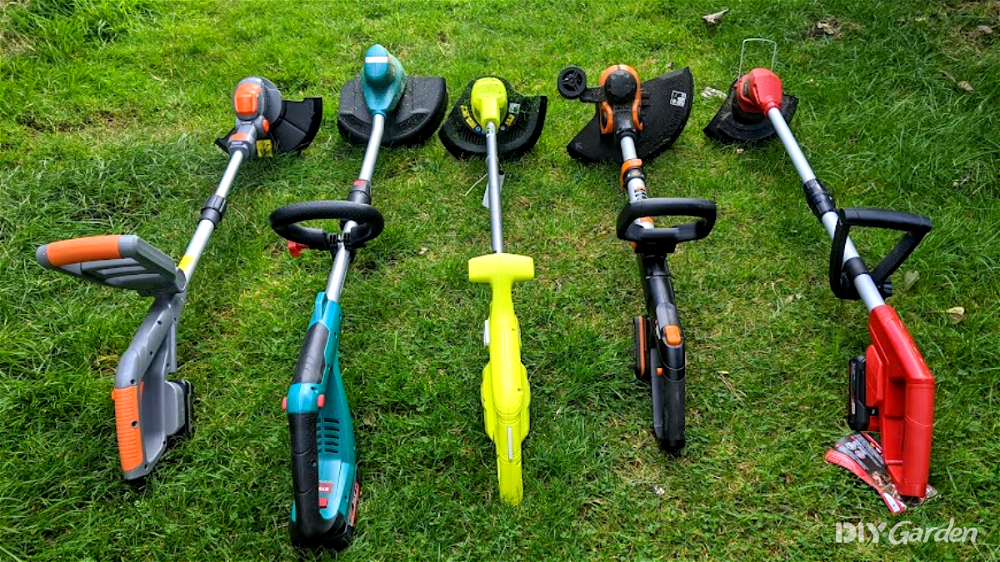
Need some help finding the best cordless strimmer? We’ve spent over 75 hours testing the UK’s top models on dense farmland and residential gardens. We tested everything from cutting power to noise levels to battery life. Our top pick is the WORX GT 3.0 Cordless Grass Strimmer scoring an impressive 4.7 out of 5. Read on to find out why it we think it’s so good…
-
Best cordless strimmer overall - WORX GT 3.0 Cordless Grass Strimmer
-
Best for edges - BLACK+DECKER Cordless String Grass Trimmer
-
Best for brambles - Einhell GC-CT Cordless Grass Strimmer
-
Budget option - Ryobi OLT1832 ONE+ Cordless Grass Trimmer
-
Good for an allotment - Bosch Advanced Grass Cut 36 Cordless Strimmer
Cordless Strimmer Reviews
1. WORX GT 3.0 Cordless Grass Strimmer
Best cordless strimmer overall
- Adjustable shaft, handle, and head makes this cordless strimmer more versatile, as well as comfortable to use
- The 2.0Ah battery charges in just one hour
- Has an edging function that works well on lawns
- Can cope with all types of vegetation - long and short grass, light weeds, and thick vegetation
- Lightweight at 2.4 kg - it won’t leave your arms aching!
- Thick vegetation needs to be cut down in 2-3 sections, which takes a lot more time
- The 2.0Ah battery only lasts for 30 minutes - you’ll need to purchase a larger battery if you want to strim for longer
- Weight
- 2.4kg
- Cutting Width
- 30cm
- Battery Included?
- Yes
- Charge Time
- 60m
- Max. Run Time
- 30m
- Battery
- 2.0 Ah lithium-ion
- Power
- 20V
- Max. Speed
- 7600 RPM
- Noise Level
- 80dB
- Telescopic Shaft?
- Yes
- Assembly Ease
- 5
- Design
- 5
- Battery
- 4
- Performance
- 4
- Ease of Use
- 5
- Noise
- 5
- Safety
- 5
- Value for Money
- 5
WORX is known for producing high-quality garden tools, one of which is the GT 3.0 Cordless Grass Strimmer. A 2-in-1 tool that also has an edger function, this strimmer is packed with features and also marked at a reasonable price.
The WORX GT 3.0 required very little assembly – it was up and running in less than 5 minutes. However, you may want to spend a little more time exploring its many adjustable features – from the shaft, to the handle, to the angle of the head – these can all be altered to make the strimmer as easy and comfortable to use as possible.
Whilst the strimmer felt lightweight to hold, its power was evident as soon as it was turned on.
It handled the easy stuff (long, thick grass and light weeds) without a problem, but did struggle with thicker vegetation. However, you’ll still be able to strim dense areas by cutting thicker stems in two or three sections (rather than in a single swipe) – it’ll just take a little longer.
The battery that came with this cordless grass trimmer had a run time of around 30 minutes, but you can’t expect too much from a 2.0Ah battery. The fact that it charges in just 1 hour is a huge plus, and you always have the option of purchasing a larger battery.
The WORX GT 3.0 would be considered a mid-range cordless trimmer. It costs a little more than some of the budget options, but it’s not as pricey as high-end models. Nevertheless, it offers just as many, if not more, features as several of the high-end strimmers out there.
Even if you don’t use the edger function very often, the adjustable design, push-button cable feeder, and sheer power of this strimmer make it, in our opinion, one of the best cordless strimmers for the UK market and a worthwhile purchase for gardens of all sizes.
Did you find this review helpful?
2. BLACK+DECKER Cordless String Grass Trimmer[ SAVE 39% ]
Best for edges
- This is an impressive grass trimmer for the price. Powerful enough for domestic use, and supplied with a battery and charger, it’s everything you need to keep the garden tidy.
- It’s an excellent edging tool as well as weed trimmer. Converting to edging mode is easy, and the included guide wheel means you’re always edging at the right height.
- I was really impressed with the weight of this trimmer. Under 3 kg with a battery in place makes it usable for just about anyone, and it doesn’t really need a shoulder strap.
- Adjusting the length of the shaft and switching between cutting and edging modes is simple. You twist the locking collar then change the length. Wonderfully easy to manage.
- You should invest in some extra batteries if you want to squeeze more than 20 minutes of trimming time out of this machine. It’s power hungry and only comes with a 2.0 Ah battery.
- The tiny little charger that comes with the trimmer might be very portable, but it’s slow. You can expect to wait for several hours before your batteries are fully charged again.
- It’s nice to have some control over the cutting speed with eco mode and boost mode settings, but the low speed is not powerful enough for heavy weed whacking.
- Weight
- 2.6 kg
- Cutting Width
- 28 cm
- Battery Included?
- Yes
- Charge Time
- 300 mins
- Max. Run Time
- 25 mins
- Battery
- 2.0Ah Lithium battery
- Power
- 18V
- Max. Speed
- 5500 RPM
- Noise Level
- 96 dB
- Telescopic Shaft?
- Yes
- Assembly Ease
- 4
- Design
- 5
- Battery
- 4.5
- Performance
- 5
- Ease of Use
- 4.5
- Noise
- 4.5
- Safety
- 5
- Value for Money
- 5
The BLACK+DECKER STC1820 cordless string trimmer is a brilliant budget piece of kit. If you’ve got oddly shaped patches of grass or weeds, or if you need to keep on top of your edging, this machine is quite hard to beat.
Decked out in BLACK+DECKER’s recognisable black and orange colours, it’s a lightweight 18 V trimmer that looks a bit plastic but is surprisingly robust for its size and weight. The last thing you want is a heavy garden strimmer, so the overall weight of just 2.6 kg is impressive.
You get a nicely sized ergonomic rear handle, ambidextrous safety switch, and a big front handle that can adjust to a comfortable angle easily. You can easily change the length of the shaft by twisting a locking collar in the middle too, so it’s fine for users of different heights.
A single string trimmer, it’s not quite as powerful as a heavy duty double string version, but it is strong enough to trim heavy grasses and weeds without complaint. It also boasts an auto line feed system, which means you don’t waste so much string like you would on an older style “bump” feed trimmer.
It makes a 28 cm wide cut path that isn’t adjustable compared with the Ryobi OLT1832, but it’s a happy medium that can cut small lawns and get in between bushes when you need to. An interesting feature is the two power modes you can select via a switch in front of the handle. There’s eco mode that saves power but lacks a bit of grunt, and boost mode that provides the optimum cut speed, in my experience.
Something that I think makes this the best garden strimmer for edging is the guide wheel on the string end. You simply pull and twist the shaft to convert the trimmer from horizontal to vertical mode, and the wheel means you’re always at the optimum height for cutting.
You get a 2.0 Ah battery included with the trimmer, which is about powerful enough to run on top speed for about 20 minutes. It doesn’t sound like a lot, but it should be enough to tidy up a small to medium size garden. You can, of course, run the trimmer in eco mode that will stretch the run time out a bit though.
The only thing I think lets this trimmer down somewhat is the slow charger. Being more used to fast chargers that can take a 2.0 Ah battery from dead to 100% in an hour or less, this little trickle charger is quite annoying.
The charger is very small and compact, which is nice, but it’s only rated to 0.4 mAh which means you’ll be waiting for several hours to charge your battery. Not ideal for anyone with a larger space to tidy up. You should probably buy yourself some spare batteries or invest in one of BLACK + DECKER’s fast chargers.
Overall though I think it’s a solid purchase for most households, looking to strike the balance between budget and performance.
Did you find this review helpful?
3. Einhell GC-CT Cordless Grass Strimmer[ SAVE 25% ]
Best for brambles
- The lightest cordless strimmer we tested, weighing just 1.77 kg, which makes it easy and comfortable to use
- Has an adjustable shaft that will suit people of varying heights (although it isn’t quite long enough for those over 6 feet) and enables you to strim hard-to-reach areas
- Can cope with all types of vegetation - short grass, long grass, light weeds, and thick vegetation
- Blades don’t break easily, which saves having to replace them often
- This grass trimmer can be used with all Einhell Power X-Change lithium ion batteries
- Thick vegetation needs to be strimmed in sections, which takes longer
- Doesn’t have a safety button to press alongside the trigger, meaning that the strimmer could easily be accidentally turned on
- Tall people will need to stoop when strimming, which can get uncomfortable
- Weight
- 1.77kg
- Cutting Width
- 24cm
- Battery Included?
- Yes
- Charge Time
- 120 mins
- Max. Run Time
- 55 mins
- Battery
- 2.0 Ah Lithium-ion
- Power
- 18V
- Max. Speed
- 8500 RPM
- Noise Level
- 85dB
- Telescopic Shaft?
- Yes
- Assembly Ease
- 5
- Design
- 4
- Battery
- 5
- Performance
- 5
- Ease of Use
- 4
- Noise
- 5
- Safety
- 3
- Value for Money
- 5
The Einhell GC-CT Cordless Strimmer comes with a 2.0Ah battery. Manufactured in Germany, this strimmer has been designed to keep lawn edges and flowerbeds tidy, whilst enabling you to cut hard-to-reach areas of your garden.
Assembling this strimmer only takes a few minutes. It’s been designed well, although the adjustable shaft isn’t quite long enough for tall people like myself – I had to stoop while strimming.
This strimmer cuts using plastic blades instead of a cutting line. However, this doesn’t seem to put it at any sort of disadvantage – it copes well with long grass, docks, nettles, and brambles. Even though it hasn’t been designed to cut thick vegetation, it’s powerful enough to do so. The blades are sufficiently flexible not to snap easily, even when up against vegetation that this strimmer can’t hack.
Even better, at just 1.77kg this is the lightest cordless strimmer on our list. It can be used continuously for long periods of time without tiring the arms. Its battery lasts for 45 minutes, which is very good considering its power.
Although I never really thought much of plastic blade strimmers in the past, I have to say that I’m a convert – especially when you can purchase one that’s this good for such a reasonable price.
Overall I have to say that this is one of the best cordless grass strimmers available. It offers good value for money and can cope with more than it says it will (which is particularly impressive considering its light construction).
Did you find this review helpful?
4. Ryobi OLT1832 ONE+ Cordless Grass Trimmer[ SAVE 10% ]
Budget option
- You can choose from three different angle positions on the cutting head. This means you can always find a comfortable direction whether you’re cutting grass or edging a path.
- Weighing less than 3 kg, even with a battery on board, makes this a lightweight grass trimmer that almost anyone can use comfortably. There’s no great need for a shoulder strap.
- Although this trimmer comes as a bare tool, Ryobi ONE + batteries are widely available and can be used in a huge number of 18 Volt tools, from drills to tyre inflators.
- The adjustable shaft and cutting head work together to make this a comfortable trimmer for different users. You can extend the shaft by 20 cm for taller users.
- A single string line trimmer like this is never as capable as a double string version. It can take a while to chop out heavy overgrowth as it’s not hugely powerful.
- Bear in mind that the battery you use makes a huge difference to the performance in your garden. For more than 20 minutes’ run time, you need a high capacity one on board.
- Weight
- 2.3kg
- Cutting Width
- 30cm
- Battery Included?
- No
- Charge Time
- Battery Dependent
- Max. Run Time
- Battery Dependent
- Battery
- Not included
- Power
- 18V
- Max. Speed
- 8500 RPM
- Noise Level
- 94.2 dB
- Telescopic Shaft?
- Yes
- Assembly Ease
- 5
- Design
- 4
- Battery
- 4
- Performance
- 4
- Ease of Use
- 5
- Noise
- 3
- Safety
- 4
- Value for Money
- 4.5
Japanese tool giants Ryobi make some of the best DIY level tools on the market. They’re more than capable for jobs around the home and garden, and the Ryobi OLT1832 cordless grass trimmer is a good example of an affordable garden tool.
If you’ve got lots of awkward spots in your garden that the mower can’t reach, this is an ideal piece of equipment to add to your collection.
Supplied with Ryobi’s excellent ergonomic handle shape, a telescopic shaft, and their “Easy Edge” technology that lets you flip the cutting head around to edge your paths and borders, it’s a versatile trimmer for all sorts of gardens.
The standard cut path on this trimmer is set to 30 cm, but you can reduce it to 25 cm simply by turning the line cutter around inside the blade guard. It’s a clever little extra that gives you more control over your cutting and takes some strain off the battery for higher efficiency.
One of the better features on this trimmer is the automatic line feed. Older types of trimmers used to throw out line whenever you pulled the trigger, which wasted precious line, but it’s not an issue with this one. It only lets out enough for the job unless the line gets tangled of course.
If you want to tackle thick stemmed weeds or hugely overgrown grasses, Ryobi’s solution is to include a separate cutting head. Using heavy duty green plastic blades instead of the ordinary string line, you can whack through heavy stuff easily, but they don’t last forever.
Did you find this review helpful?
5. Bosch Advanced Grass Cut 36 Cordless Strimmer[ SAVE 26% ]
Good for an allotment
- Has an edging function to keep lawns looking tidy and defined
- This grass trimmer cuts short grass and most weeds well
- The same battery can be used with other Bosch tools
- Has a semi-automatic line feed function that releases more line each time you pull the trigger, saving you from having to check the cable as you’re strimming
- Priced significantly higher than its competitors, yet doesn’t have quite as many features as other cordless grass trimmers
- Heavy duty cordless trimmer at 4.1 kg (can be used with a harness, but doesn’t come with one included)
- This was the only strimmer we tested that choked in thick grass
- The semi-automatic line feed function stops working once the battery is down to one bar - you’ll need to pull more line out manually
- Weight
- 4.1kg
- Cutting Width
- 24cm
- Battery Included?
- Yes
- Charge Time
- 60 mins
- Max. Run Time
- 35 mins
- Battery
- Ah Lithium-ion
- Power
- 36V
- Max. Speed
- Not Listed
- Noise Level
- 74dB
- Telescopic Shaft?
- Yes
- Assembly Ease
- 3
- Design
- 4
- Battery
- 5
- Performance
- 4
- Ease of Use
- 4
- Noise
- 4
- Safety
- 5
- Value for Money
- 4
Bosch is a brand that just about everyone knows and loves, so I had high hopes for the Bosch Advanced Grass Cut 36 – a cordless grass trimmer and edger that’s designed for long grass and overgrown areas.
Assembling Bosch garden tools is usually a simple task, but this cordless trimmer required quite a bit of strength to put together. As long as that’s not an issue for you, assembly should only take about 15 minutes.
From its colours and design to its numerous features, everything about this grass strimmer screams Bosch. In my eyes, that’s a good thing – this is a brand that has a solid reputation for quality and reliability.
Starting with the positives: this strimmer does well on short grass and most weeds, including brambles and docks.
However, it was a little disappointing when tackling long grass: it quickly became tangled which caused the strimmer to choke.
Having a battery life of 35 minutes means this strimmer is best suited to medium gardens or an allotment.
That said, you could easily swap out the 2.0Ah battery for something more powerful, which is especially easy to do if you already own other battery-powered Bosch power tools as of course the same battery can be used across their cordless range. With a larger battery, it would work well in large gardens too.
This strimmer’s weight is both a pro and a con. At 4.1 kg, it feels solid and sturdy. However, it’s also the heaviest of the cordless grass trimmers I tested – you’ll need to purchase a shoulder harness for long periods of use.
All in all, I did expect a little more from this Bosch grass strimmer – mostly because it’s advertised as being able to tackle long grass (which it can’t, really). Nevertheless, it works well on shorter grass and some thicker vegetation.
If you have a small garden, I would recommend going with a more cost-effective option. However, if you’re a Bosch fan, and having a larger garden this is a solid option – particularly if you can upgrade the battery.
Did you find this review helpful?
Product Testers
We tested various cordless strimmers with varied designs, features, and prices. Some were more suitable for heavy-duty use or bigger gardens, while others suited smaller gardens and budgets much better! Throughout this review, we assessed:
- Assembly Ease: Most strimmers can be assembled within a few minutes, so we deemed any models that took over 10 minutes too long for the average gardener. We checked the assembly instructions to see if these were clear and had diagrams and rated them down if they didn’t.
- Design: To be ranked high, models needed to demonstrate the right balance between weight and power. Cordless strimmers weighing 2.5 kg were best for long-term use as well as short bursts of activity, so they were rated higher than heavier models. For strimmers weighing more than 3 kg, we assessed whether the design accommodated this, such as with a harness. Designs with adjustable cut paths (ideally 25 – 30 cm) were rated higher as they could be used for both lawns and more difficult places, like in between bushes, improving the versatility of the strimmer.
- Battery: Battery life and charge time determine how quickly you can strim your garden, so any battery that lasted less than 30 minutes was seriously marked down, as this wouldn’t typically be enough time for a large or some medium-sized gardens. Also, charge times of above an hour and a half were rated down as this is too long to wait, particularly if you have a larger garden.
- Performance: To assess performance, we tested each model on a range of vegetation of different lengths and thicknesses, including long, thick grass, light weeds, and thicker vegetation. Any models that could handle both light and thicker organic material were given top marks. We also tested the models in hard-to-reach areas, like between bushes, as this truly tested how skilled they were in terms of their performance. The double-string models received a better review in terms of performance because they’re more powerful and, thus, more versatile than the single-string designs.
- Ease of Use: The most comfortable cordless strimmers feature ergonomic rear and front handles, a telescopic shaft, and a push-button or automatic line feeder. Because of this, any models that included this combination of features were rated as some of the best in terms of ease of use.
- Noise: Noise levels over 70 dB can damage your hearing if you’re around it for a long time, so it was vital to test the noise levels of each model. The models varied drastically in how noisy they were. Models that were powerful yet retained low noise levels (of 85 dB or below) were given the best ratings, while less powerful models producing over 90 dB of noise were ranked lowest.
- Safety: The main safety feature strimmers can have is a safety switch alongside the trigger. Models with a safety switch – and even better, an ambidextrous and easily accessible one – we deemed safer, so we rated them higher.
- Value for Money: The cordless strimmers that had more than one function – such as an edger or shrub function – demonstrate better value for money in my eyes. If these models also have extra features like a guide wheel, foot pedal, or plant guard and are still affordable to most gardeners, these got top marks in terms of value for money.
Compare Product Features
Use the dropdown to sort the table by the feature you want to see.
WORX GT 3.0 Cordless Grass Strimmer
- 4.8
- 2.4kg
- 30cm
- Yes
- 60m
- 30m
- 2.0 Ah lithium-ion
- 20V
- 7600 RPM
- 80dB
- Yes
BLACK+DECKER Cordless String Grass Trimmer
- 4.7
- 2.6 kg
- 28 cm
- Yes
- 300 mins
- 25 mins
- 2.0Ah Lithium battery
- 18V
- 5500 RPM
- 96 dB
- Yes
Einhell GC-CT Cordless Grass Strimmer
- 4.5
- 1.77kg
- 24cm
- Yes
- 120 mins
- 55 mins
- 2.0 Ah Lithium-ion
- 18V
- 8500 RPM
- 85dB
- Yes
Ryobi OLT1832 ONE+ Cordless Grass Trimmer
- 4.2
- 2.3kg
- 30cm
- No
- Battery Dependent
- Battery Dependent
- Not included
- 18V
- 8500 RPM
- 94.2 dB
- Yes
Bosch Advanced Grass Cut 36 Cordless Strimmer
- 4.1
- 4.1kg
- 24cm
- Yes
- 60 mins
- 35 mins
- Ah Lithium-ion
- 36V
- Not Listed
- 74dB
- Yes
How to Choose The Best Cordless Strimmer
Using a cordless strimmer is an excellent way to achieve a tidy lawn, with none of the back-breaking effort of using lawn shears or scissors.
Compared to other designs, cordless grass trimmers are one of the best options to go for – you’re not held back by a mains cable, or the weight of a petrol strimmer.
Often, corded electric strimmers need to be used with an extension lead in the garden, and this can be a lot of effort. By comparison, a cordless trimmer save a lot of hassle. Ultimately, if the strimmer is easy to use, you’ll be more likely to get it out the shed.
READ NEXT: The Best Grass Strimmers
If you’re after a new cordless grass trimmer, there are a few things to bear in mind to make sure you’re getting the best one. The information below should give you an idea of what to look out for, and also what to avoid:
How Grass Trimmers Work
Grass trimmers tend to use one of two cutting mechanisms: a cutting line, or cutting blades.
Here’s a description of each type, as well as their pros and cons.
Cutting Line Strimmers
Cordless trimmers that use a cutting line have one or two lines of nylon string inside the head of the strimmer. They cut using centrifugal force; whilst the line is no good for cutting when at rest, it becomes stiff and blade-like when it spins quickly.
As the line wears down, new line needs to be fed into the cutting head from the spool. Sometimes this is done manually, but most cordless trimmers have a system in place to make this process automatic or semi-automatic.
There are two main systems for distributing more line: ‘bump feed’ and ‘automatic feed’.
Strimmers with a ‘bump feed’ system require you to ‘bump’ the end of the strimmer on the ground to release more line. This means that you’re in control of when to release more line, and can help control how quickly it is used.
‘Automatic feed’ strimmers release more line each time the machine is turned back on. This can help ensure you’re never using weak, blunt line. However, it can sometimes result in using line too fast, which becomes expensive. If you’re using a cordless grass trimmer, you’ll likely keep turning off the unit to save battery as you move around the garden. It can therefore be wasteful if new line is automatically released each time you turn the unit on.
Some people prefer the automatic system to the ‘bump feed’ system, you just need to be aware that it could use more line.
There are also single-line and double-line strimmers. Single-line strimmers have less cutting force than double-line strimmers, but that isn’t necessarily a bad thing. It just depends what job you are doing. Some people find that a grass trimmers with a double cutting line is too strong: they can damage tree trunks, flower pots or fencing if you get too close.
Bladed Strimmers
A design which is slowly growing in popularity, bladed strimmers generally have two nylon blades on the head of the strimmer which spin at speed. As they spin, they generate a lot of cutting power.
The blades are replaceable, and generally you’ll need to replace a blade after every 2 hours of use. This is because they can get damaged, and occasionally they’ll come off and get lost in the garden.
Generally, about 10 – 20 spare blades will come included with the strimmer, with replacement packs of around 30 blades available for about £10 online.
In terms of cutting power, blades and cutting line are pretty evenly matched. Some gardeners have grown tired of messing with cutting line and prefer the bladed models, but others don’t enjoy having to replace the blades.
How to Use a Cordless Strimmer
Cordless strimmers naturally require you to be slightly more organised compared to mains-powered tools – charging the battery needs to be done in advance to avoid disappointment when it’s time to tackle the garden.
If you don’t wear the battery all the way down, you’re unlikely to need to recharge it before using it again; the lithium-ion batteries used in cordless tools hold their charge relatively well. Of course, charging before use will make sure that you get the most run-time possible from your cordless machine.
Generally speaking, using a cordless grass trimmer is quite intuitive. There is usually a simple start button which will start the motor going. Some machines have a safety button as well as a start trigger, requiring both to be pushed to avoid accidental start-ups.
It may take a bit of practise initially, as well as trial and error, to work out where the cutting line is, but it doesn’t take long to master.
One side of the grass trimmer will host the cutting edge, and debris will shoot out from the other side. Experiment until you know which is which, otherwise you’ll walk against the cutting direction.
Go slowly with the strimmer regardless of whether it’s an edging job or a tougher task – rushing can cause an uneven cut (and can also be dangerous) so it’s better to take your time to avoid having to go back over the same spot twice. With tougher plants, it can help to tackle them in sections. If a cordless trimmer can’t immediately tackle the thick stem of a weed, it can help to cut from the top down and cut it gradually.
Finally, look out for tripping hazards. Bricks, small fences, garden ornaments, cats, dogs and small children can all trip you up when you’re concentrating on creating a perfect line. It’s best to clear the parameters first, just to be sure.
Why Choose Cordless Over Mains Powered?
Cordless trimmers and mains-powered trimmers work well in the garden. Petrol models are also available, although they’re less commonly used for domestic use so here we’re going to focus on electric models. There are pros and cons to cordless and mains-powered strimmers, which are covered below:
Mains Powered Strimmers
Mains-Powered grass trimmers are powerful and there’s no battery to run down – their run-time is essentially limitless. They can often cut through slightly thicker vegetation than battery-powered models.
However, these strimmers can cause problems sometimes. Some people worry about cutting through the cord with the strimmer, which is easier to do than you might think. Also, as mentioned above, mains-powered strimmers limit you in terms of where you can go in the garden. Generally, they have a mains cable of up to 10 m long, so for anything larger than a small garden, or for reaching awkward places, an extension cable will be needed. This can be a hassle, as well as a tripping hazard.
Cordless Strimmers
Battery-powered strimmers have a limited amount of run-time before you need to stop and charge them. However, how long the battery lasts for depends on its size and power. Some cordless grass trimmers will have a battery than only lasts 20 minutes, but others (normally with a battery of 4 Ah or more) can last around 30 – 40 minutes depending on the job.
Naturally, one of the main benefits of a battery-powered strimmer is that they are much easier to manoeuvre than their corded counterparts. Not only is there no potentially-hazardous cord to accidentally cut or trip over, but there’s no cord restricting your movement either.
As with a lot of things, personal preference will likely dictate whether you choose a mains-powered or battery-powered strimmer. It also depends on the job you are doing, whether you need slightly more power with a mains-powered option, or prioritise the freedom of cordless tools.
In terms of power, there is now some crossover between battery-powered models and mains-powered ones, especially in the mid-range price bracket. So, the biggest caveat is the battery run-time of cordless strimmers. This is something that has greatly improved over the last couple of years, so it’s best to look for a tool that has 30 – 40 minutes run time. 20 minutes may not be enough. Of course, if you buy more batteries, you can keep swapping them out to continue with the job. There are few strimming jobs that will really require more than an hour’s work, making cordless a no brainer for a lot of people.
READ NEXT: The Best Cordless Strimmers For An Allotment
Choosing the Most Comfortable Design
Here are a few things to look out for when looking for the best grass trimmers:
- Handles – an ergonomic handle is a great plus, and a second handle further down the shaft makes strimming much easier. The second handle balances out the weight to avoid ending up with one aching arm. The design of the second handle can differ, and some people find a real handle more comfortable than just a raised hand-hold.
- Telescopic shaft – Adjustable shafts help you find the perfect working height and save on backache. More powerful strimmers should have a longer reach so you can hold them away from your toes. (This is a good place to say you should never strim the lawn in flip flops. Always wear sturdy boots!)
- A cutting style that you get on with – as mentioned above, strimmers can use either cutting line or cutting blades. Keep this in mind when shopping, and decide if you’re more comfortable (physically and economically speaking) replacing wire or blades when it wears out.
Wearing the Correct Attire
Protective clothing such as ear defenders for louder motors with more power can be useful, particularly if the job is going to take a while. This is particularly relevant for a petrol strimmer, but certain electric trimmers can also be very loud.
Sturdy boots are a must, and you should avoid wearing loose trailing clothes that could get caught in the strimmer.
If you’re cutting overgrown areas, protective glasses are important because strimmers can throw up stones and other sharp objects.
Wear gloves to protect your hands whilst strimming, and be aware of the need to take frequent breaks – especially if the machine vibrates a lot.
A Warning About Strimmers and Wildlife
It would be remiss not to mention the injuries strimmers can inflict on harmless wildlife.
They are great bits of kit, but use them mindfully to avoid inflicting unnecessary damage and pain.
Always rake through long grass or undergrowth first, before using cordless grass trimmers. This gives hedgehogs, frogs, toads, grass snakes, newts, mice and all our native wildlife a chance to escape.
Bear in mind that creatures like hedgehogs would rather curl up to avoid danger, so make sure you move any garden furniture, watch what you’re doing and never put a cordless trimmer somewhere you can’t see the cutting line.
Cordless Strimmer FAQs
Naturally, battery run-time varies between cordless strimmer models. However, the most common battery life for a cordless strimmer to have is between 30 – 40 minutes.
Battery life depends on the job you’re doing – if you’re simply cutting lawn grass or a garden path where your lawn mower can’t reach, you can expect to achieve the upper ends of the maximum run-time.
However, if you’re cutting through thicker undergrowth, and especially if you’re having to use a ‘turbo’ setting, you’ll use up the battery quicker – maybe even in as little as 20 minutes.
- Firstly, make sure the strimmer is unplugged or turned off.
- Next get out your spare strimmer line.
- Remove the casing and place the new line on the spool’s starter hole, winding it around the directional arrows.
- It’s worth taking your time to make sure it’s neatly done, otherwise the strimmer may jam and you’ll have to start again. When you reach maximum capacity, or come to the end of your strimmer line, cut it with around six inches to spare and fix the end into the spool’s eyelets.
- Then you’ll need to put the spool back in, making sure the line matches up with any outer eyelets.
- Finally replace the strimmer casing by lining up the tabs and pressing until it clicks.
It may take some time to figure this out as it can vary between strimmers, so always retain the instruction booklet. There are some helpful videos online too.
A bump-feed system requires you to push the head of the strimmer into the ground to prompt more line to be released.
This gives you control over when more line gets used, but can sometimes be unreliable and difficult to use.
An automatic-feed system sees new line getting released automatically everything time the strimmer is turned on.
This is often quite reliable, but can result in line being used up more quickly than necessary.
If you’re worried about having to buy line more often, you might consider a strimmer with a bump-feed system. If that doesn’t concern you as much, and you just want the most straight-forward option, consider an automatic-feed system.
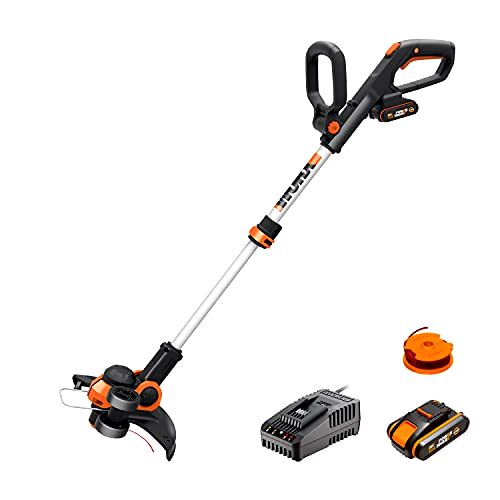
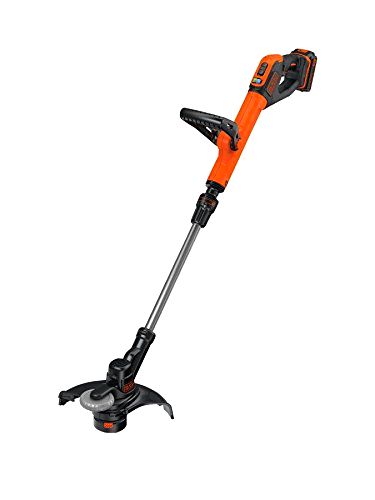
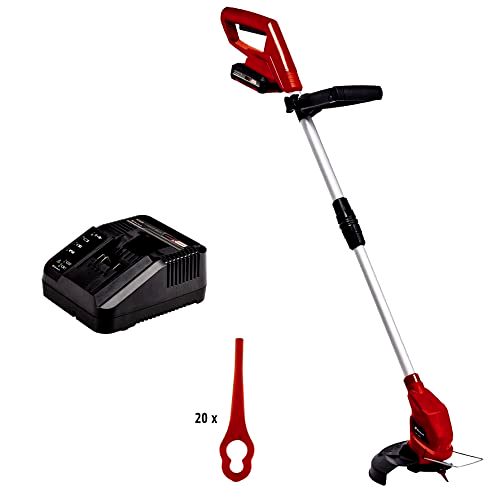
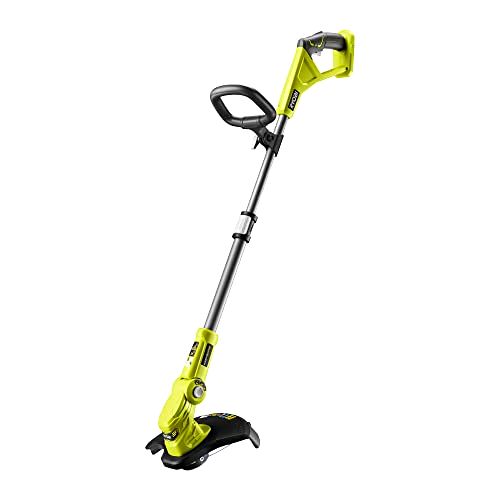
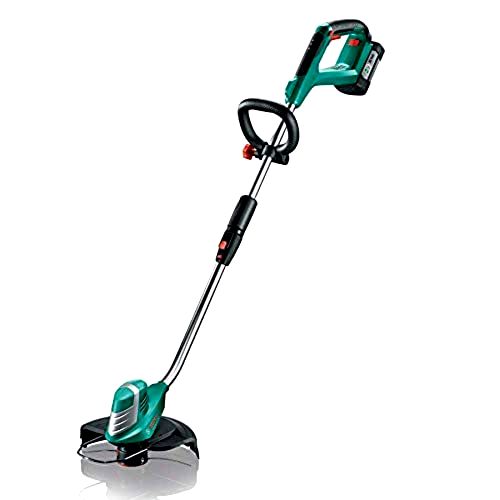
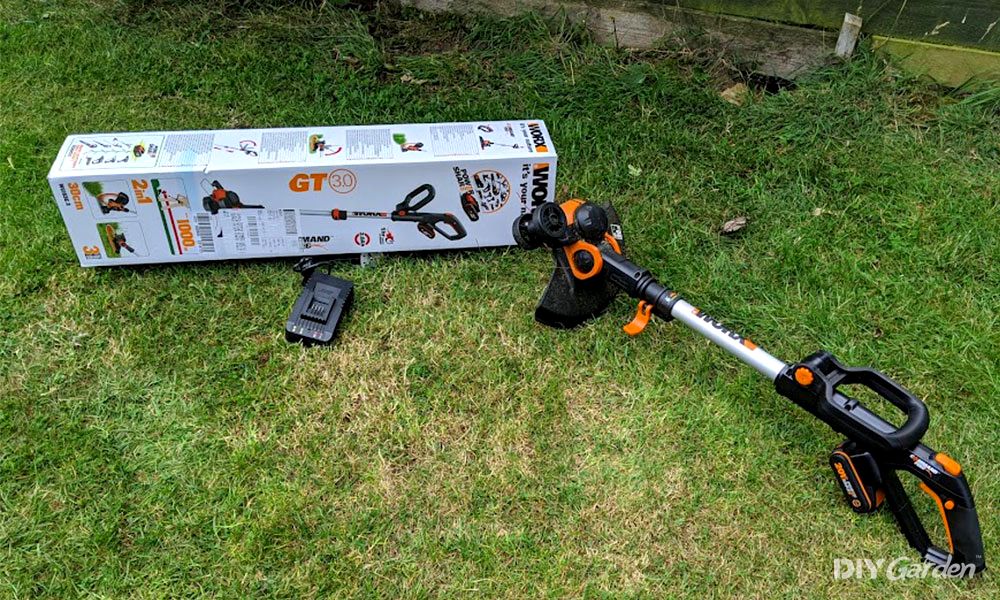
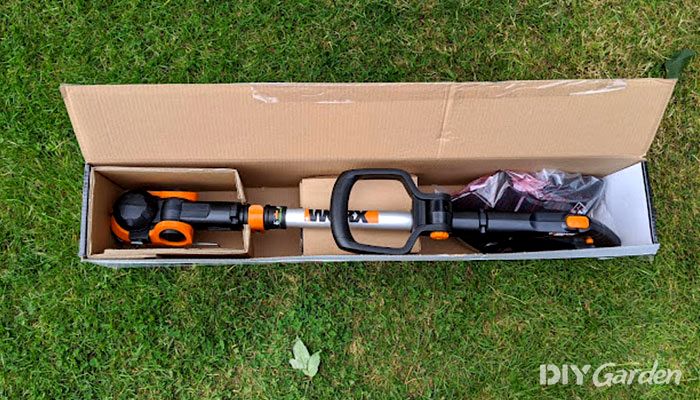
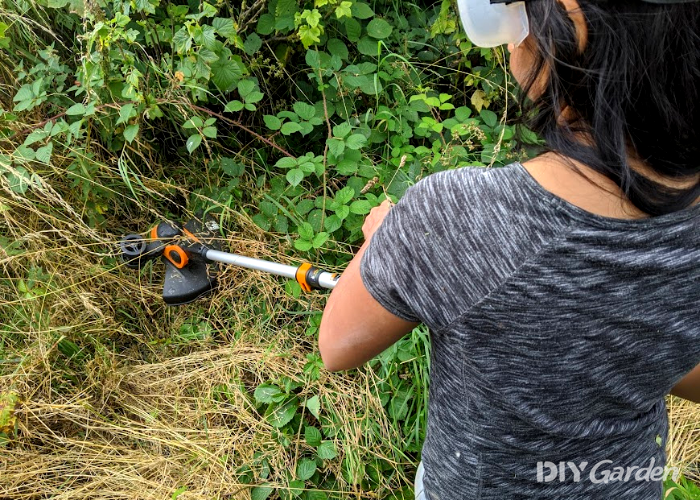
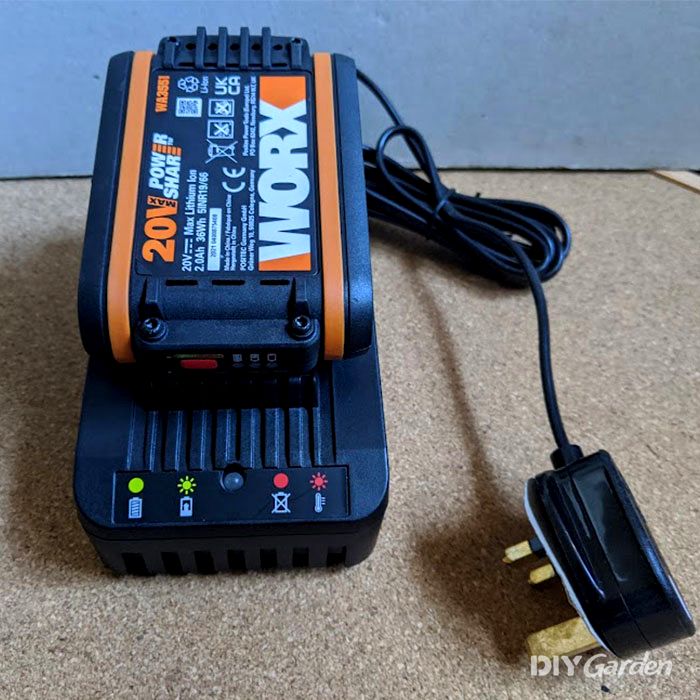
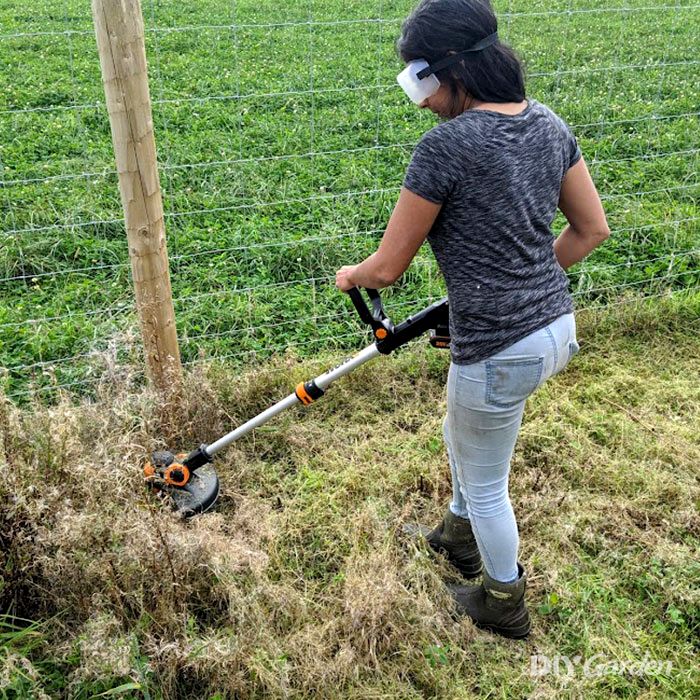
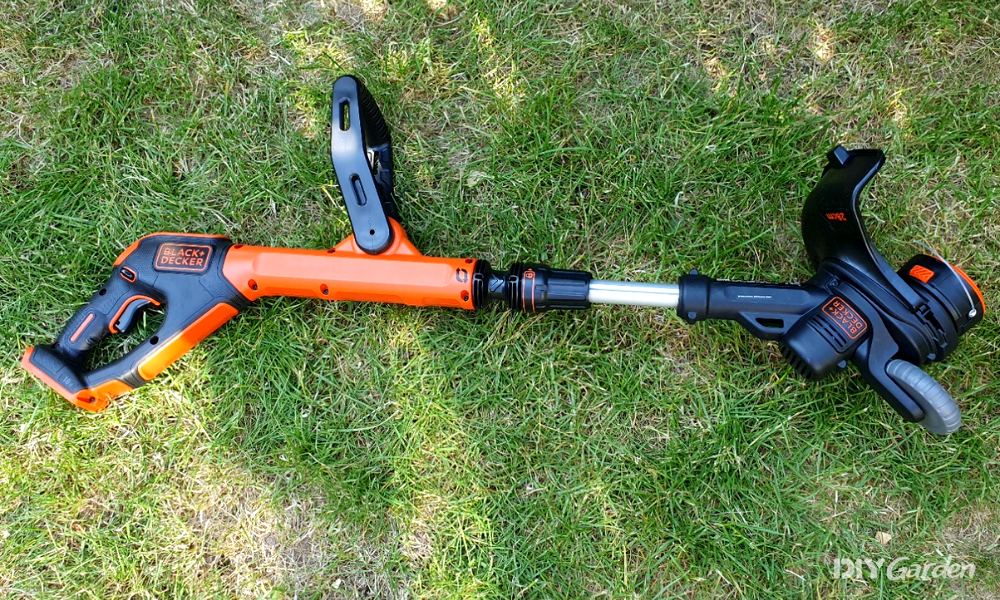
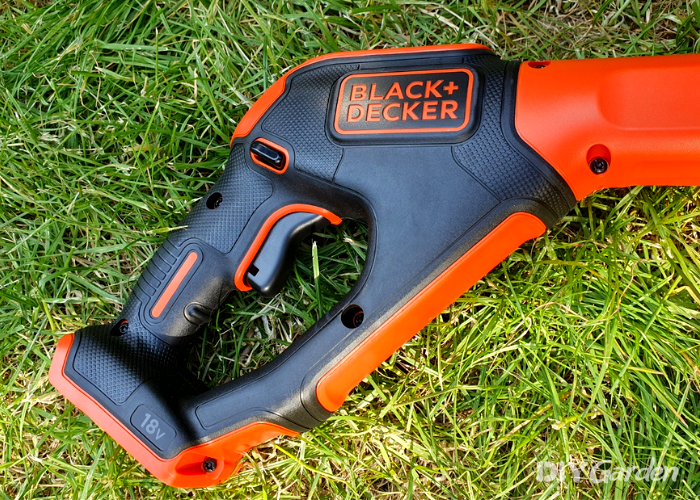
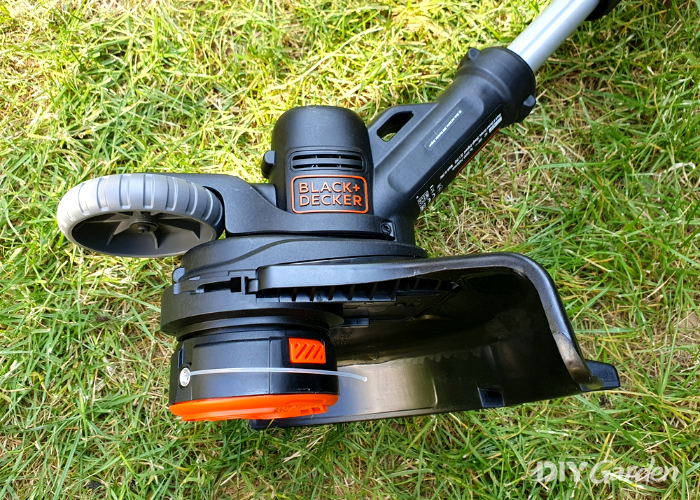
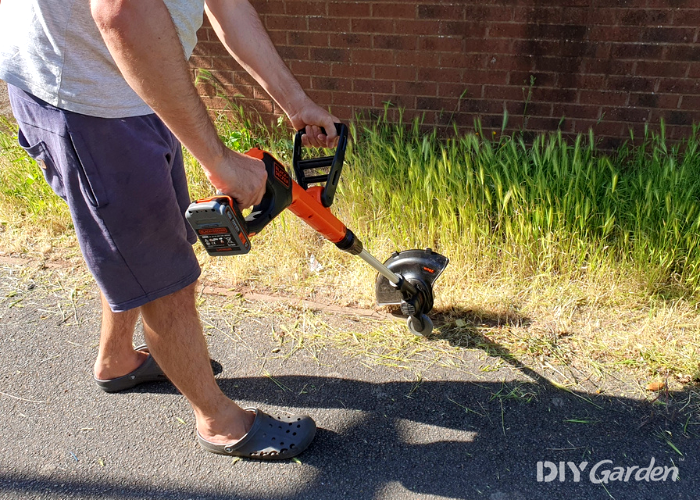
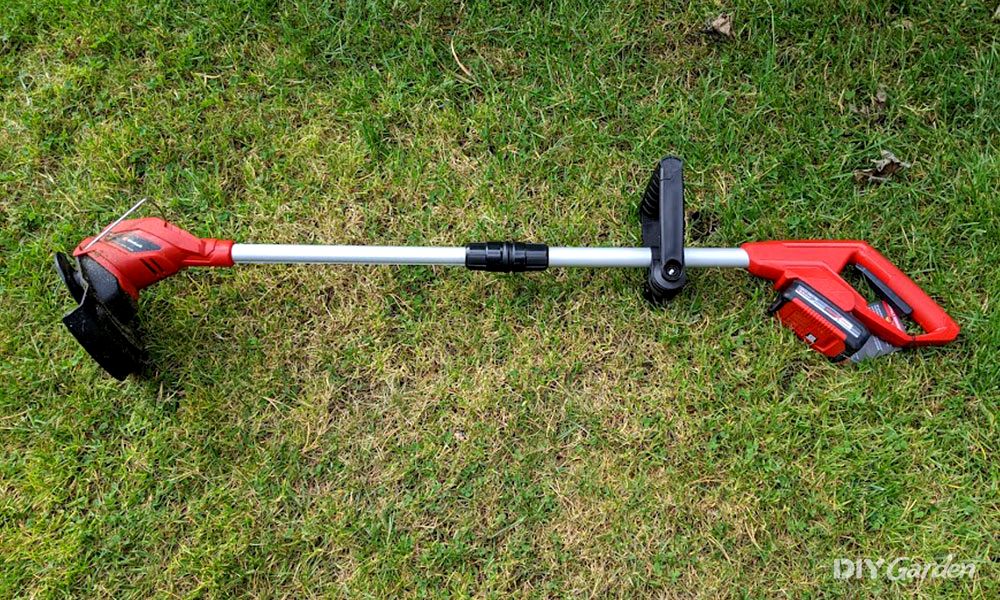
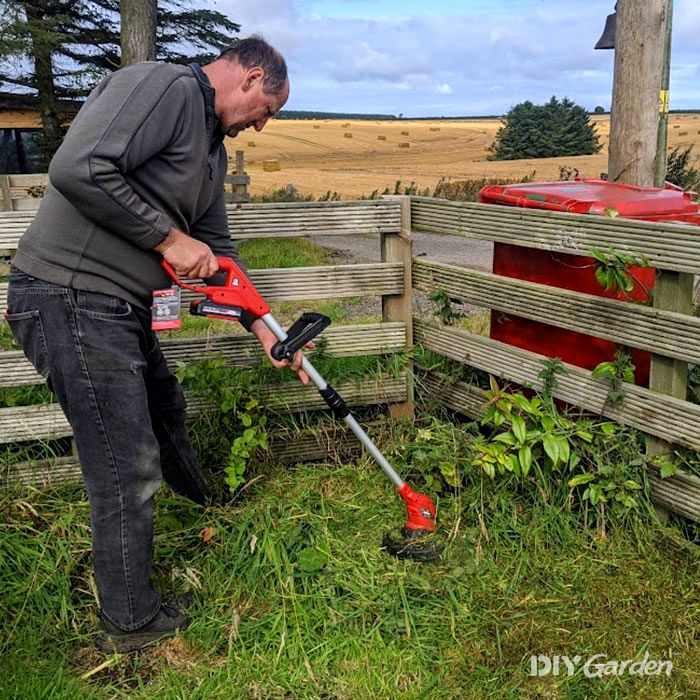
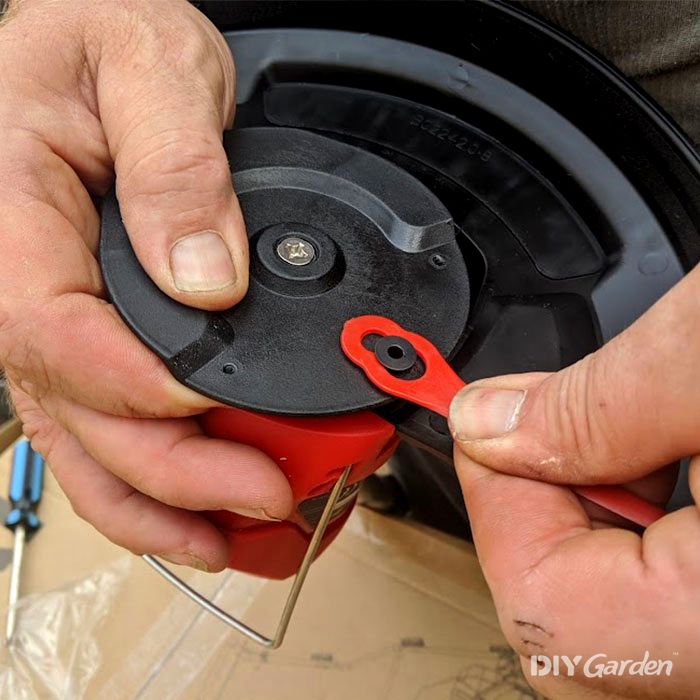
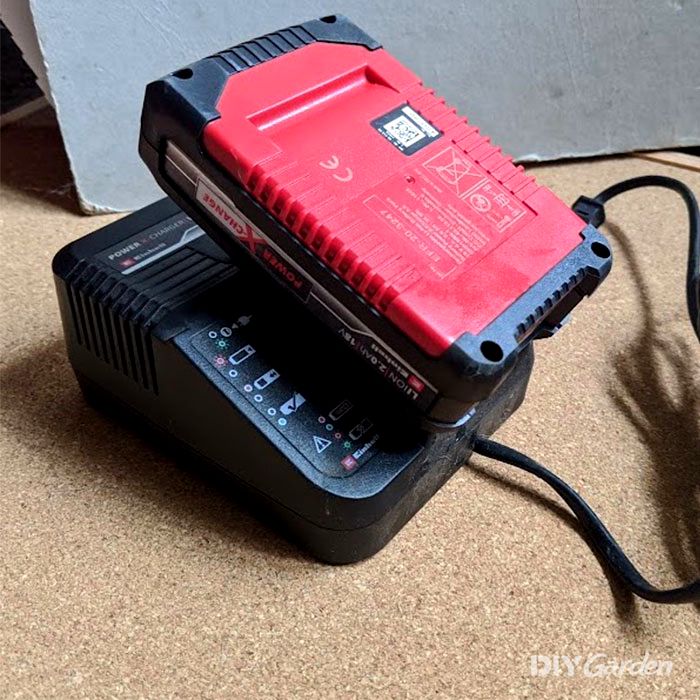
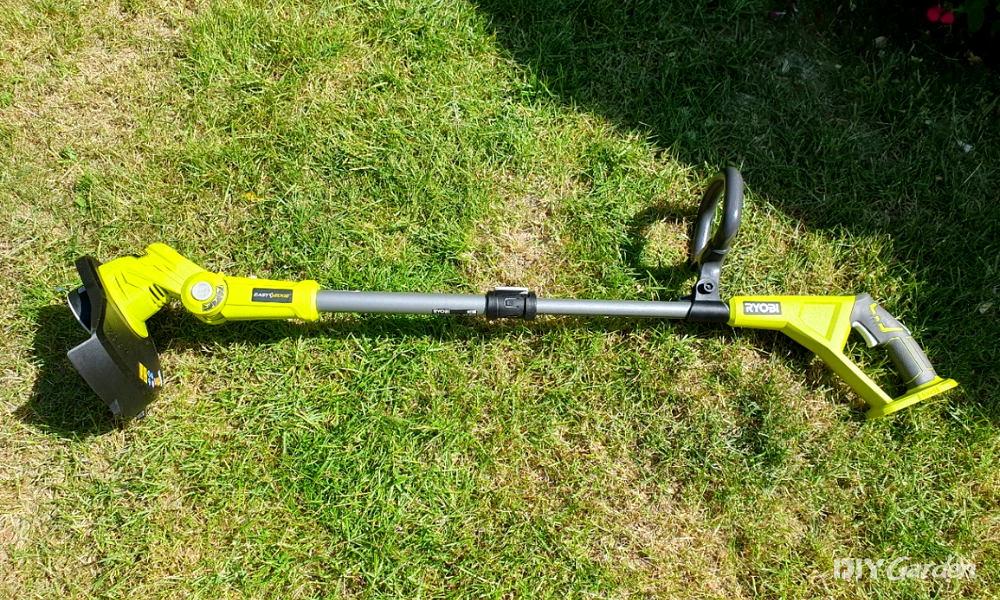
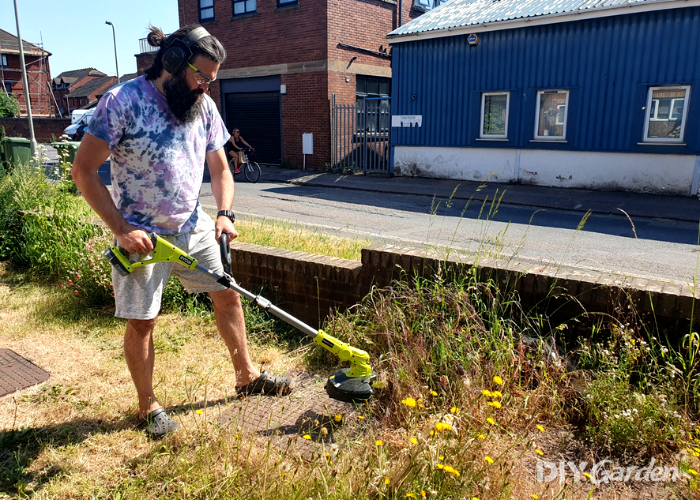
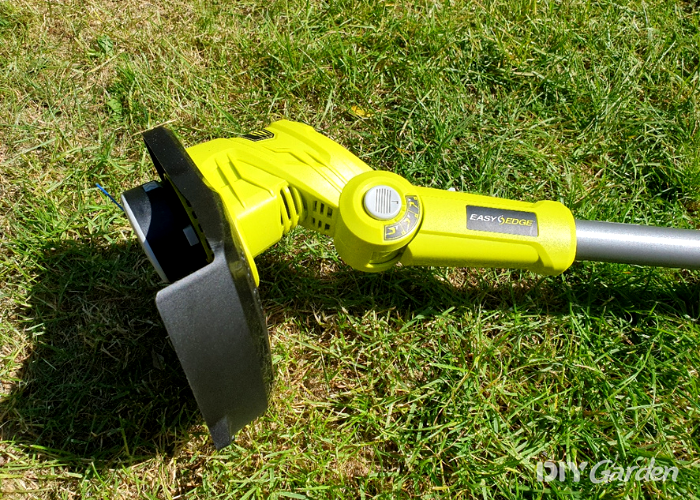
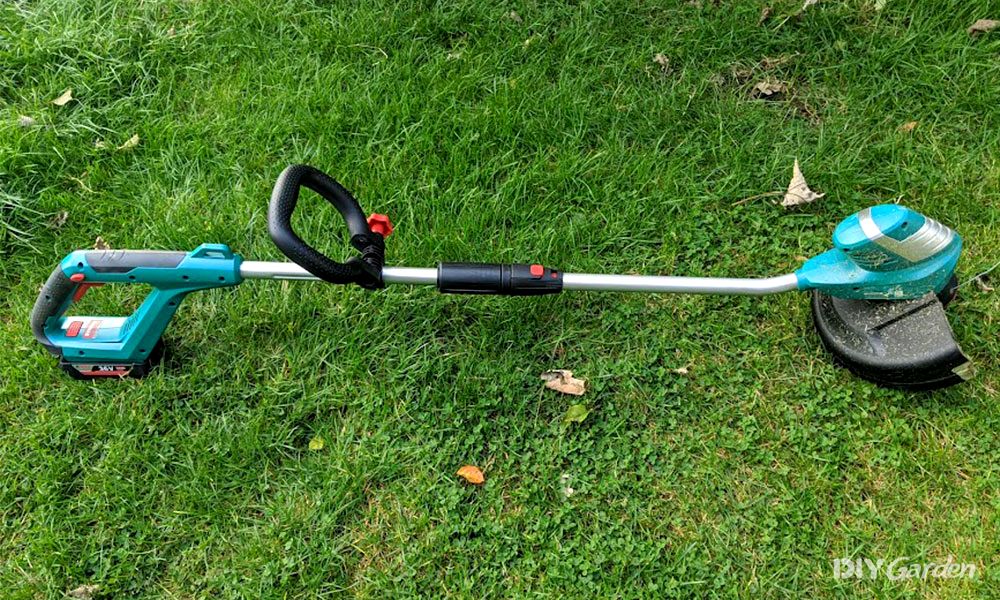
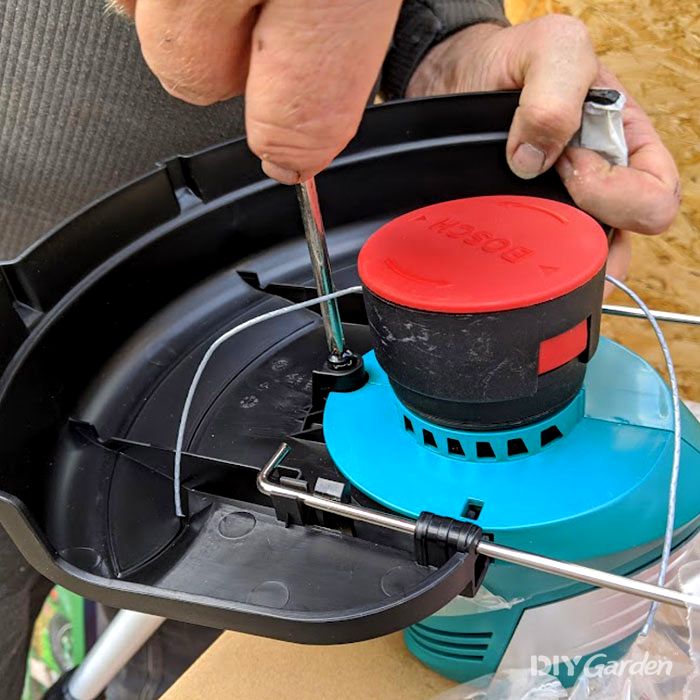
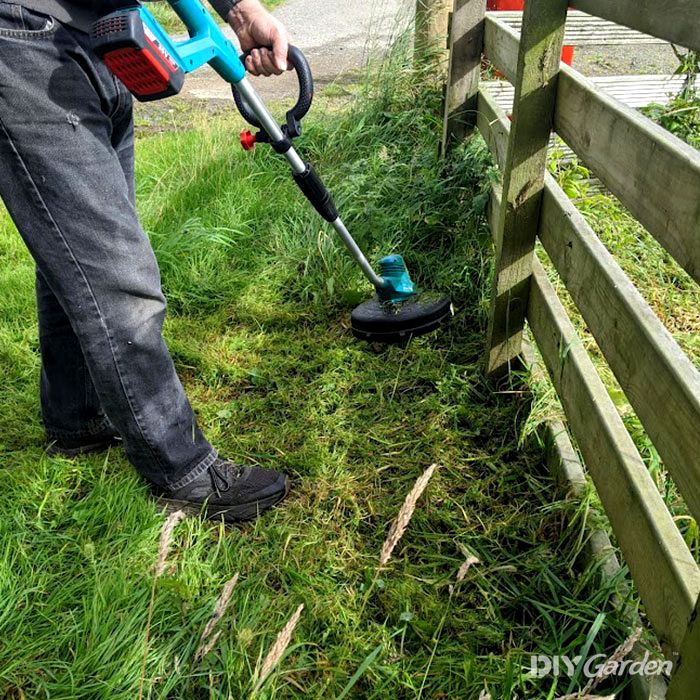
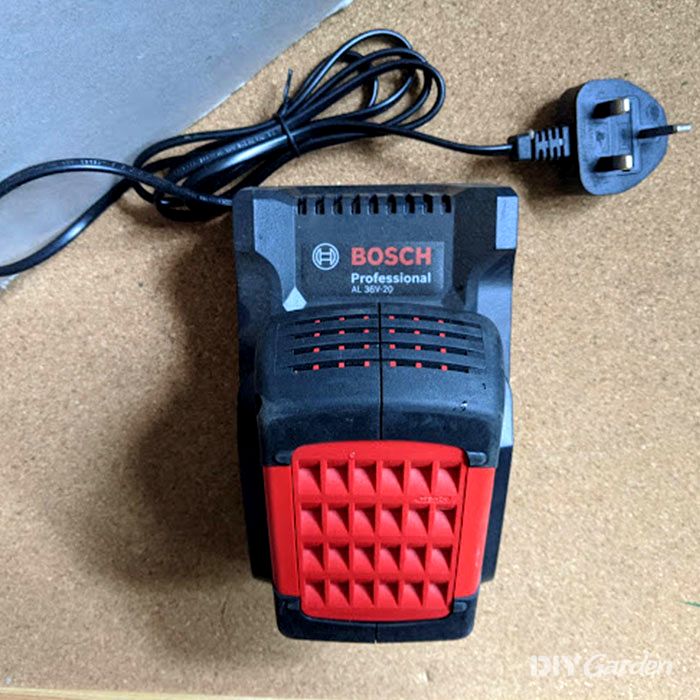
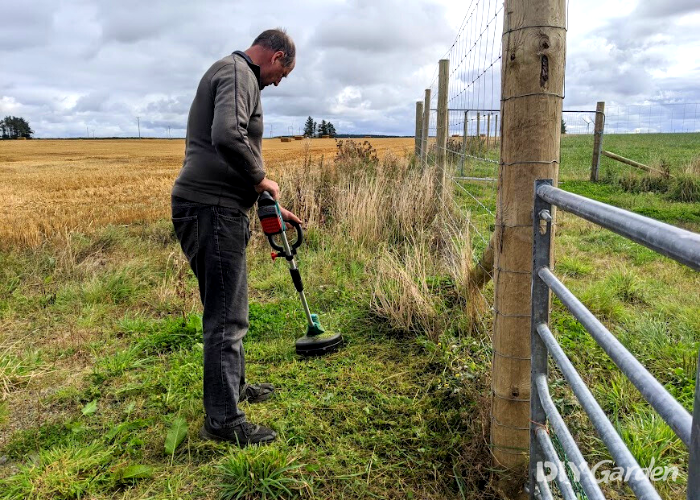

Share